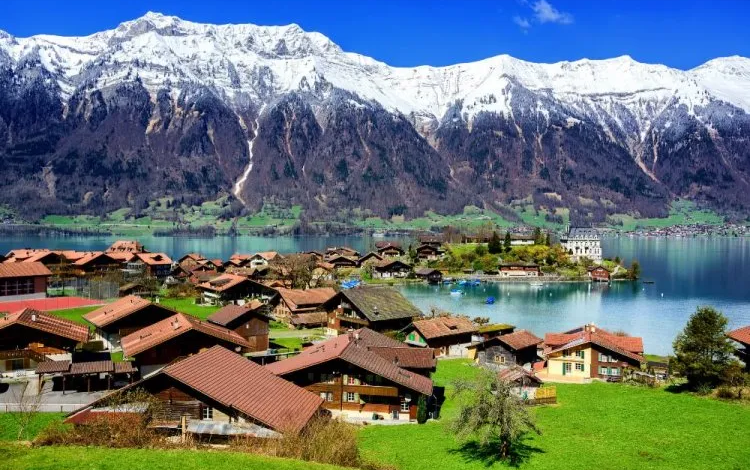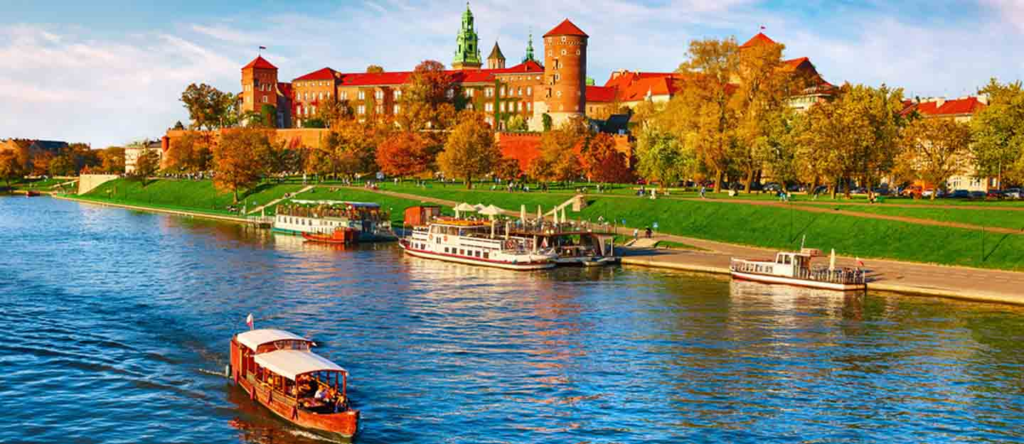Discovering the Charms of Poland: Top Destinations for Travel and Tourism

Discovering the Charms of Poland: Top Destinations for Travel and Tourism
Introduction:
Poland, a country steeped in history, vibrant culture, and breathtaking landscapes, has emerged as an increasingly popular tourist destination. From medieval cities to picturesque countryside, Poland offers a diverse range of attractions for travelers. In this article, we will explore some of the best places to visit when traveling to Poland, ensuring an unforgettable experience.
- Warsaw:
As the capital and largest city of Poland, Warsaw is a vibrant metropolis that beautifully blends the old with the new. Visitors can explore the historic Old Town, a UNESCO World Heritage site, where colorful facades and cobblestone streets transport you back in time. The Royal Castle, Warsaw Uprising Museum, and Lazienki Park with its iconic Palace on the Water are must-visit attractions. Warsaw also offers a thriving culinary scene, bustling markets, and a vibrant nightlife. - Krakow:
Known for its rich history and architectural wonders, Krakow is a city that captivates visitors with its charm. The UNESCO-listed Old Town is a treasure trove of Gothic and Renaissance architecture, with the magnificent Wawel Castle and St. Mary’s Basilica as its highlights. The historic Jewish Quarter of Kazimierz adds a unique cultural dimension to the city. Just outside Krakow lies the somber Auschwitz-Birkenau Memorial and Museum, a poignant reminder of World War II atrocities. - Wroclaw:
With its picturesque canals, colorful facades, and lively atmosphere, Wroclaw is often referred to as the “Venice of Poland.” The Market Square, lined with stunning Gothic and Baroque buildings, is the heart of the city. Visitors can explore the famous Wroclaw University and its stunning Aula Leopoldina, stroll along the Oder River, and visit the enchanting Wroclaw Cathedral Island. The city is also known for its charming gnomes, which can be spotted throughout the streets. - Gdansk:
Situated along the Baltic Sea, Gdansk is a historic port city with a rich maritime heritage. The colorful facades of the Long Market and the iconic Neptune Fountain are symbols of the city’s prosperity. St. Mary’s Church, with its towering Gothic spires, offers panoramic views from its observation deck. Visitors can also explore the Westerplatte Peninsula, the site of the first battle of World War II, and the European Solidarity Centre, which commemorates the Polish labor movement. - Zakopane and the Tatra Mountains:
For nature lovers and outdoor enthusiasts, a visit to Zakopane and the Tatra Mountains is a must. Zakopane, nestled at the foot of the mountains, is a popular destination for hiking, skiing, and experiencing the vibrant local culture. The stunning landscapes of the Tatra National Park provide endless opportunities for exploration, with scenic hiking trails, crystal-clear mountain lakes, and breathtaking vistas. - Bialowieza Forest:
Located on the border between Poland and Belarus, Bialowieza Forest is a UNESCO World Heritage site and one of Europe’s last and largest primeval forests. It is home to the iconic European bison, a symbol of the region’s conservation efforts. Visitors can explore the forest on guided tours, observing its unique flora and fauna, and visit the Bialowieza National Park Museum to learn about the forest’s ecological importance.:
- Poland, with its rich history, diverse landscapes, and warm hospitality, offers an array of attractions for travelers. Whether you’re exploring the historic cities of Warsaw, Krakow, and Gdansk, immersing yourself in the natural beauty of Zapopan and the Tatra Mountains, or discovering the pristine wilderness of Bialowieza Forest, Poland promises a remarkable travel experience. With its captivating architecture, cultural heritage, and breathtaking scenery, Poland has something to offer every traveler seeking to uncover the charms of this enchanting Central European country.

Here are some more details about travel, tourism, and additional places to visit in Poland:
- Torun:
Torun, a UNESCO World Heritage site, is a beautifully preserved medieval city located on the banks of the Vistula River. It is renowned as the birthplace of the famous astronomer Nicolaus Copernicus. Visitors can explore the picturesque Old Town, characterized by its Gothic architecture and charming cobblestone streets. The city is also known for its gingerbread tradition, and visitors can learn about this sweet treat at the Living Museum of Gingerbread. - Poznan:
Poznan, one of Poland’s oldest cities, offers a mix of historical landmarks and vibrant cultural scene. The Old Market Square is a focal point, with its colorful townhouses, the iconic Town Hall, and the charming Billy Goats Clock, which comes to life every noon. Poznan also hosts the International Fair, attracting business travelers and tourists alike. For a tranquil escape, visitors can explore the beautiful Citadel Park or visit the nearby Lake Malta for recreational activities. - Bialystok:
Situated in northeastern Poland, Bialystok is a city rich in history and cultural heritage. The Branicki Palace, often referred to as the “Polish Versailles,” is a magnificent Baroque residence surrounded by beautifully landscaped gardens. Visitors can also explore the Podlasie Museum, which showcases the cultural diversity of the region. Bialystok is an excellent base for exploring the nearby Bialowieza Forest and the historic town of Tykocin. - Lublin:
Lublin, known as the “Gate to the East,” offers a unique blend of history, architecture, and cultural experiences. The Old Town features well-preserved medieval buildings, including the impressive Lublin Castle and the beautiful Trinity Tower. Majdanek Concentration Camp, located just outside the city, serves as a somber reminder of the Holocaust. Lublin also hosts numerous festivals throughout the year, showcasing music, theater, and traditional Polish customs. - Masurian Lake District:
The Masurian Lake District in northeastern Poland is a paradise for nature lovers and outdoor enthusiasts. With over 2,000 lakes interconnected by picturesque canals and rivers, it offers ample opportunities for boating, sailing, and kayaking. Visitors can explore the charming lakeside towns of Mikolajki and Gizycko, hike through the lush forests, and enjoy the tranquility of the pristine natural surroundings. - Wieliczka Salt Mine:
Located near Krakow, the Wieliczka Salt Mine is a fascinating underground world that has been in operation for over 700 years. The mine features intricate salt carvings, stunning chapels, and even an underground lake. Visitors can take guided tours to explore the labyrinthine tunnels and learn about the history and significance of salt mining in the region. - Slowinski National Park:
Situated along the Baltic Sea coast, Slowinski National Park is known for its unique sand dunes and diverse ecosystems. Visitors can hike through the shifting sand dunes, relax on the pristine beaches, and explore the coastal lakes and marshes. The park is also a haven for birdwatching enthusiasts, with various species of migratory birds making their stopovers in the area.
Poland’s travel and tourism offerings extend beyond the well-known destinations such as Warsaw, Krakow, and Gdansk. With its wealth of historical sites, natural wonders, and vibrant cultural experiences, Poland invites visitors to delve deeper into its diverse landscapes and rich heritage. Whether exploring medieval cities, pristine lakes, or underground wonders, Poland promises an enriching and unforgettable journey for travelers seeking to uncover the hidden gems of this captivating country.

Here are some additional details about travel, tourism, and cultural highlights in Poland:
- Bieszczady Mountains:
The Bieszczady Mountains in southeastern Poland offer a serene and unspoiled natural landscape. This remote region is known for its rolling hills, dense forests, and picturesque villages. It’s an ideal destination for hiking and wildlife spotting, with the chance to encounter European bison, wolves, and lynx. The Bieszczady National Park is home to diverse plant and animal species, and its scenic trails provide an immersive experience in nature. - Gniezno:
Gniezno is a historic city with significant cultural and religious importance. It was the first capital of Poland and remains an important spiritual center. The highlight of Gniezno is the Gniezno Cathedral, where the tombs of Polish kings can be found. The city’s vibrant Old Town offers charming streets, colorful buildings, and traditional Polish cuisine. Visitors can also explore the nearby Lednica Landscape Park, which features beautiful lakes and forests. - Malbork Castle:
Malbork Castle, located near Gdansk, is the largest brick castle in the world and a UNESCO World Heritage site. This medieval fortress was the headquarters of the Teutonic Order and played a significant role in the region’s history. Visitors can take guided tours of the castle, exploring its grand halls, medieval weaponry, and impressive architecture. The castle also hosts various events and reenactments, offering a glimpse into medieval times. - Bialowieza National Park:
Bialowieza National Park, shared between Poland and Belarus, is a UNESCO World Heritage site and a primeval forest of immense ecological importance. It is home to the last remaining European bison herd, as well as numerous rare plant and animal species. Guided tours allow visitors to explore the dense forest, witness the majestic bison in their natural habitat, and learn about the park’s conservation efforts. - Warsaw Uprising Museum:
The Warsaw Uprising Museum is a poignant reminder of the city’s history during World War II. It commemorates the Warsaw Uprising of 1944, a major act of resistance against Nazi occupation. The museum houses a vast collection of exhibits, including photographs, personal accounts, and artifacts, providing a comprehensive portrayal of the uprising and its impact on the city and its people. - Folklore and Festivals:
Poland is known for its rich folklore and vibrant festivals that celebrate its cultural heritage. The annual St. Dominic’s Fair in Gdansk is the largest open-air trade and cultural festival in Poland, featuring traditional crafts, music, and entertainment. The Krakow Christmas Market is a magical event, with stalls selling handmade crafts, delicious food, and traditional Polish Christmas decorations. Other notable festivals include the Pierogi Festival in Krakow and the Juwenalia student festival held in numerous university cities. - Polish Cuisine:
Exploring Polish cuisine is an essential part of any visit to the country. Traditional dishes like pierogi (dumplings), bigos (hunter’s stew), and golabki (stuffed cabbage rolls) offer a taste of Polish culinary traditions. Visitors can also savor regional specialties such as oscypek (smoked cheese) in the Tatra Mountains or fresh fish dishes along the Baltic Sea coast. Polish vodka, particularly brands like Zubrowka and Wyborowa, is renowned worldwide and worth sampling.
Conclusion:
Poland offers a wealth of travel and tourism opportunities, from its stunning natural landscapes to its rich historical and cultural heritage. Whether it’s exploring remote mountains, visiting medieval castles, immersing in the stories of World War II, or indulging in traditional Polish cuisine, there is something for every traveler. Poland’s diverse attractions and warm hospitality combine to create an enriching and memorable experience for those seeking to delve deeper into the country’s hidden treasures.



